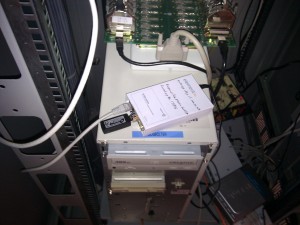Communicating with a Firefox extension from Selenium
Monday, May 20th, 2013Edit: I think this now longer works with more recent versions of Firefox, or at least I have given up on this strategy and gone for extending Webdriver to do what I want instead.
For something I am currently working on I wanted to use Selenium to automatically access some parts of Firefox which are not accessible from a page. The chosen method was to use a Firefox extension and send events between the page and the extension to carry data. Getting this working was more tedious than I was expecting, perhaps mainly because I have tried to avoid javascript whenever possible in the past.
The following code extracts set up listeners with Selenium and the Firefox extension and send one event in each direction. Using this to do proper communication and to run automated tests is left as an exercise for the author but hopefully someone else will find this useful as a starting point. The full code base this forms part of will be open sourced and made public at some future point when it does something more useful.
App.java
package uk.ac.cam.cl.dtg.sync;import java.io.File;
import java.io.IOException;import org.openqa.selenium.JavascriptExecutor;
import org.openqa.selenium.WebDriver;
import org.openqa.selenium.firefox.FirefoxDriver;
import org.openqa.selenium.firefox.FirefoxProfile;public class App {
private static final String SEND = "\"syncCommandToExtension\"";
private static final String RECV = "\"syncCommandToPage\"";public static void main(String[] args) throws IOException {
// This is where maven is configured to put the compiled .xpi
File extensionFile = new File("target/extension.xpi");
// So that the relevant Firefox extension developer settings get turned on.
File developerFile = new File("developer_profile-0.1-fn+fx.xpi");
FirefoxProfile firefoxProfile = new FirefoxProfile();
firefoxProfile.addExtension(extensionFile);
firefoxProfile.addExtension(developerFile);
WebDriver driver = new FirefoxDriver(firefoxProfile);
driver.get("about:blank");
if (driver instanceof JavascriptExecutor) {
AsyncExecute executor = new AsyncExecute(((JavascriptExecutor) driver));
executor.execute("document.addEventListener( " + RECV + ", function(aEvent) { document.title = (" + RECV
+ " + aEvent) }, true);");
executor.execute(
"document.dispatchEvent(new CustomEvent(" + SEND + "));");} else {
System.err.println("Driver does not support javascript execution");
}
}/**
* Encapsulate the boilerplate code required to execute javascript with Selenium
*/
private static class AsyncExecute {
private final JavascriptExecutor executor;public AsyncExecute(JavascriptExecutor executor) {
this.executor = executor;
}public void execute(String javascript) {
executor.executeAsyncScript("var callback = arguments[arguments.length - 1];"+ javascript
+ "callback(null);", new Object[0]);
}
}
}
browserOverlay.js Originally cribbed from the XUL School hello world tutorial.
document.addEventListener(
"syncCommandToExtension", function(aEvent) { window.alert("document syncCommandToExtension" + aEvent);/* do stuff*/ }, true, true);// do not try to add a callback until the browser window has
// been initialised. We add a callback to the tabbed browser
// when the browser's window gets loaded.
window.addEventListener("load", function () {
// Add a callback to be run every time a document loads.
// note that this includes frames/iframes within the document
gBrowser.addEventListener("load", pageLoadSetup, true);
}, false);function syncLog(message){
Application.console.log("SYNC-TEST: " + message);
}function sendToPage(doc) {
doc.dispatchEvent(new CustomEvent("syncCommandToPage"));
}function pageLoadSetup(event) {
// this is the content document of the loaded page.
let doc = event.originalTarget;if (doc instanceof HTMLDocument) {
// is this an inner frame?
if (doc.defaultView.frameElement) {
// Frame within a tab was loaded.
// Find the root document:
while (doc.defaultView.frameElement) {
doc = doc.defaultView.frameElement.ownerDocument;
}
}
// The event listener is added after the page has loaded and we don't want to trigger
// the event until the listener is registered.
setTimeout(function () {sendToPage(doc);},1000);
};
};

